The best electric car is the one you never have to plug in.
A hybrid electric car – like the Toyota Prius. It has all of the advantages of an electric car – including the ability to be plugged in (if you buy the plug-in version) and run on battery alone – for about 25 miles – without ever having to worry about plugging in because it can recharge itself, as you drive.
It also has twice the range of any purely electric car – more than 600 miles – so you don’t have to stop for gas very often, either.
It’s an example of an electric car that makes a lot of sense – which is probably why so many people have bought one.
What It Is
The Prius is the original hybrid – the first-mass produced partially-electric car.
Like an electric car, this compact-sized hatchback has a battery pack and electric motors. Unlike an electric car, it never runs out of charge – or range – unless you run out of gas. This eliminates the main problem besetting electric cars – having to plan your drive around your range, because of the time and inconvenience involved in recharging electric cars.
The Prius also addresses another electric car problem – their cost. You won’t spend a cent on gasoline if you buy an EV – but you’ll spend a fortune on the EV. The least expensive model – Nissan’s Leaf – costs $27,400 (for the base version with a smaller battery and just 150 miles of range). A Leaf with a higher-capacity battery and 226 miles of range lists for $32,400. Other “entry-level” EVs like the Chevy Bolt are similarly pricey.
A Prius stickers for $24,525 to start for the L Eco trim – saving you about $4k at the starting gate vs. the lowest-priced EV currently available (Nissan’s Leaf) and leaving aside the cost of only being to travel about 150 miles in between charge sessions in the Leaf. (unless you spend another $4k-plus for the one that goes 226 miles).
You can also get all-wheel-drive, something rival hybrids like the Hyundai Ioniq ($23,400 to start) don’t offer. The cost so equipped is $27,135 for the LE AWD e trim. 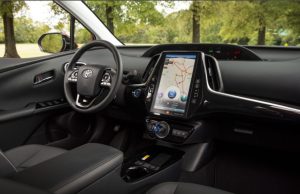
A plug-in variant called the Prime is also available. This one differs from the standard Prius hybrid in that you can plug it in to a household outlet to recharge its batteries – and thereby use no gas to recharge the batteries. It can also travel about 25 miles on battery power alone – just like an electric car. But when it runs out of electric-only range, you don’t have to stop for a charge. Like the standard Prius, the Plug-in also recharges its batteries as you drive, using the gas engine that forms the other side of the hybrid drivetrain as a carry-it-with-you generator.
Base price for the Prius Prime is $28,200. 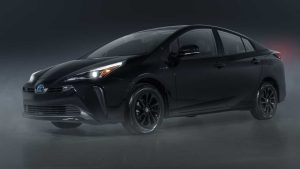
What’s New
To visually jazz up the Prius a bit, Toyota has added a Nightshade package to the list of available options. It includes black-anodized wheels and trim plus rain-sensing wipers, keyless entry a heated steering wheel and simulated leather seat covers and door panel surfaces.
What’s Good
An electric car that makes practical, economic and environmental sense.
Hatchback layout provides ample room for carrying large, unwieldy items (such as a 4×4 fence post).
AWD is available – other hybrids in the class like the Hyundai Ioniq and Kia Niro don’t offer it.
What’s Not So Good
Center-mounted LCD touchscreen interface is not easy to use while driving.
Lacks the quickness that comes standard with most EVs.
Hyundai Ioniq costs less and is more conservatively styled.
Every Prius comes with the same 1.8 liter, 121 horsepower gas engine – on the one side of the hybrid drivetrain – paired up with a battery pack/electric motors (on the other side of the drivetrain).
The standard Prius comes with a smaller battery pack that assists the gas engine in propelling the car and powering accessories when the gas engine is not running, as when the car is stationary or during deceleration/coasting. The standard Prius can also be driven about a mile at speeds up to about 25 MPH on battery power. 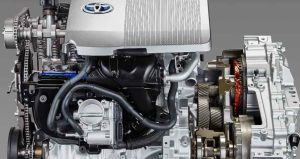
The plug-in Prius has higher-capacity battery pack that can propel the car at normal road speeds for about 25 miles. Its battery pack can also be charged by . . . plugging it in. But – like the standard Prius – you don’t have to plug it in. Both versions carry around their own generator – the 1.8 liter gas engine – which not only recharges the battery pack, it prevents the battery pack from being emptied of charge.
This is a huge hybrid plus rarely discussed. 
Because electric cars rely solely on their batteries for propulsion, the batteries are often heavily discharged. This discharge/recharge cycling is what ages a battery pack, much in the way that hammering a gas engine all the time usually results in that engine blowing blue smoke out the tailpipe after a short while.
In a hybrid, the batteries are always maintained at a certain level of charge, reducing “wear and tear” on them. They’re also worked less hard because they’re only partially responsible for propelling the car and powering everything in the car – as in an electric car (including even the heater).
This is important – if you care about saving money – because electric car battery packs are extremely expensive. A hybrid’s battery pack is less expensive – because it’s not as big – and the expense of having to replace it is farther-down-the-road because it lives an easier life than an electric car’s battery pack. 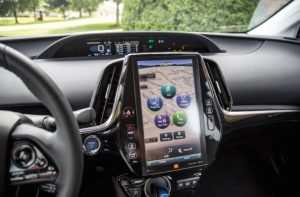
Interestingly, the standard Prius has more range – and gets slightly better gas mileage – than the plug-in version: 58 city/53 highway (and 655 miles in city driving) for the standard model vs. 55 city, 53 highway (and 627 miles of range in city driving) for the plug-in Prime. This being a function of the plug-in’s heavier battery pack.
But, the plug-in can be plugged-in. Which means not having to burn any gas to “top off” the battery pack. And because it can be driven about 25 miles without burning any gas, it is possible to burn very little gas, assuming your trip is within the 25 miles of electric-only range.
Neither version of the Prius is quick – zero to 60 takes more than 10 seconds – but unlike electric cars, the Prius just keeps on going long after the EV has had to stop and makes you wait while it recharges.
The standard model’s near-700 mile range is stupendous. It is nearly twice the range of the longest-range electric cars; models like the Tesla 3 with its extra-cost “long range” (358 miles) battery pack for half as much as it costs to buy a Tesla 3 with its “long range” battery pack ($50,990).
Certainly, the Tesla gets to 60 in less than half the time it takes the Prius to get there. But is this a performance contest? Weren’t electric cars supposed to be all about increasing efficiency?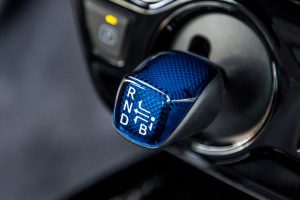
Arguably, it is precisely because EVs are so inefficient – and impractical – that they had to resort to touting how quick they are. There is nothing wrong with quickness; above all, it is fun. But if it costs a lot of money – and wastes a lot of your time – it doesn’t make a lot of sense.
Driving the Prius is much like driving an ordinary economy car. The hybrid drivetrain doesn’t call attention to itself while you’re driving – unless you roll the windows down and listen. Then you may notice the silence, while in “EV” mode. The gas engine is automatically cycled off and on – and you can watch the flow in real time via the display in the main gauge cluster or the larger LCD touchscreen mounted in the center stack.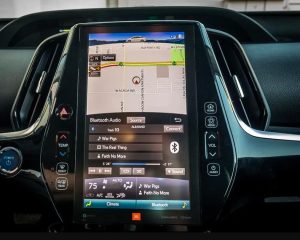
This where the Prius differs from an ordinary economy car – and from other hybrids, like the Hyundai Ioniq and its Kia-cousin, the Niro. It has a funky and not very functional interior layout. The main gauge cluster is located equidistant between the driver and front seat passenger at the top of the dashpad – which is ok because it’s still in the driver’s line of sight and provides the pertinent information he needs, such as speed and fuel remaining.
The large, centrally mounted LCD touchscreen that comes standard in the top-of-the-line Limited trim is another matter.
Tesla pioneered this kind of interface and Toyota seems to be emulating Tesla in this respect. But here’s the problem: Many necessary operational controls – for example, the temperature/fan speed settings – practically require you to stop paying attention to the road while you pay attention to the LCD screen, making sure you tap/swipe the right control. This is almost impossible to do without looking – which isn’t good when you’re moving.
The good news is the oversized/poorly situated 11.6 inch Tesla-emulating touchscreen is optional. So you can avoid it. The standard L,LE and XLE trims come with a smaller 7-inch touchscreen and more ergonomic push-button controls for most accessories that can be easily operated without taking your eyes off the road.
The Prius is the most recognizable hybrid – deliberately so.
Toyota purposely designed it to look unlike other cars. Some like the car’s looks. Some do not like them. Its styling can be polarizing – but it hasn’t been a problem for Toyota, which has sold this car in numbers far exceeding those of any rival and all electric cars, combined.
Something almost everyone will like about this car is its expansive side glass, which tapers downward toward the front of the car so that by the time it reaches the driver/passenger side, the view to the side is superior vs. many other modern cars. The door tops are low enough that you can almost rest your elbows on them with the windows rolled down, too.
Another inarguability is the hatchback layout, which greatly ups the practicality quotient by making it feasible to use this car for things Toyota probably never intended it to be used for – such as carrying home a 4x4x6 fence post from Lowes, with the rear hatch closed.
One more thing that’s hard to gainsay is that because it’s so affordable, you can afford to buy more than just efficiency. The XLE trim comes loaded with heated seats covered in SofTex simulated leather, rain-sensing wipers, keyless entry, wireless phone charging and so on – plus that near-700 mile range, without the wait – for about the same as Nissan wants for the base-trim Leaf without such amenities and with only 150 miles of range.
One nettle is that some desirable options – such as the 10 speaker JBL audio system that comes standard in the Limited (along with the Tesla-style touchscreen) aren’t available a la carte in the lower-priced trims.
Also, AWD is only available with the the standard Prius; the plug-in version is FWD-only.
The Rest
Electric-only cars are said to be better for the environment. But are they, really? Their much larger battery packs burn up more natural resources – and energy to make them. They draw more power, to recharge them. And because of all that heavy discharge-recharge cycling, their battery packs will almost certainly not last as long and so will need to be replaced sooner – with another resource-gobbling/energy-hogging battery pack.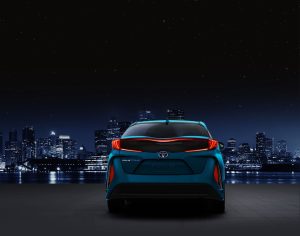
The Prius may not be 100 percent “zero emissions.” But isn’t it enough to be nearly that? Especially when EVs aren’t, really – and when their forbidding cost precludes their purchase by people who aren’t affluent enough to indulge them?
The Bottom Line
If you’d like to just drive – without having to constantly think about how soon you’ll have to stop – the Prius might jut be the right electric car for you.
. . .
Got a question about cars, bikes or anything else? Click on the “ask Eric” link and send ’em in! Or email me at EPeters952@yahoo.com if the @!** “ask Eric” button doesn’t work!
If you like what you’ve found here please consider supporting EPautos.
We depend on you to keep the wheels turning!
Our donate button is here.
If you prefer not to use PayPal, our mailing address is:
EPautos
721 Hummingbird Lane SE
Copper Hill, VA 24079
PS: Get an EPautos magnet or sticker or coaster in return for a $20 or more one-time donation or a $10 or more monthly recurring donation. (Please be sure to tell us you want a magnet or sticker or coaster – and also, provide an address, so we know where to mail the thing!)
My eBook about car buying (new and used) is also available for your favorite price – free! Click here. If that fails, email me at EPeters952@yahoo.com and I will send you a copy directly!


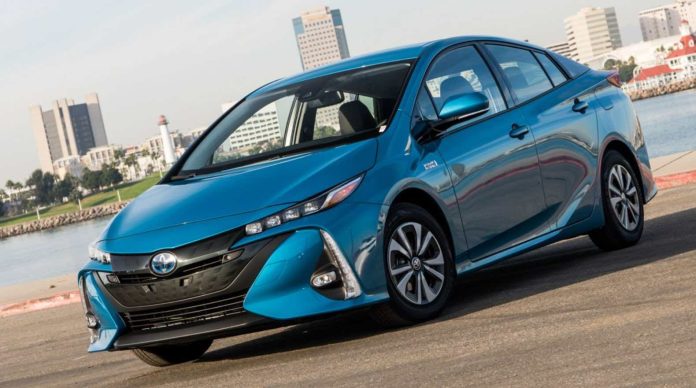

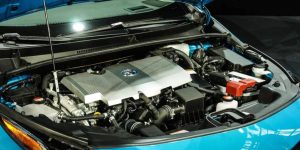
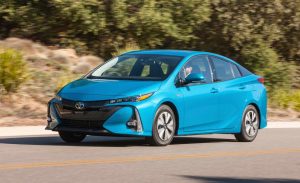








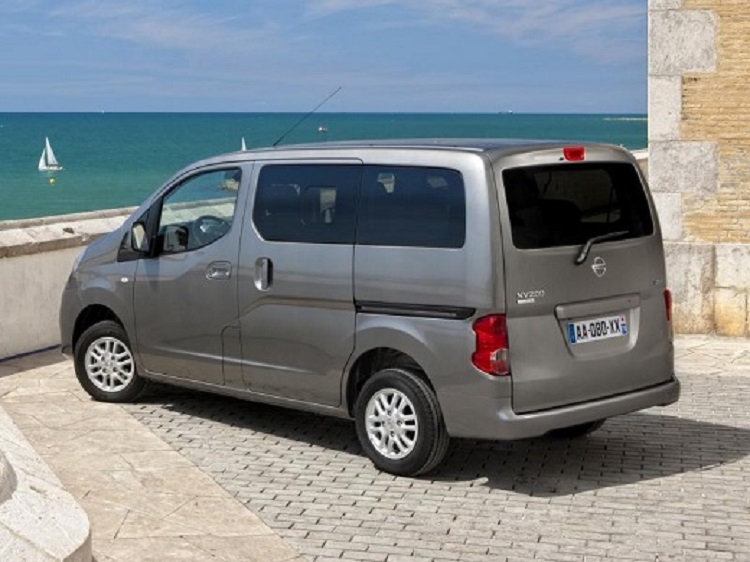
Recently sold my 2007 Prius (bought a BMW X3). I didn’t really want a Prius or any car, as I was living in NYC with street parking (like you have to move it almost daily) but it was free (inherited). It had only 64K miles. I sold it for $6K to a dealership with 84K miles. Had it for about 5 years. Total cost for maintenance and repair during that time was around 3K including tires, battery etc. Check engine light was becoming a problem (tire censors).
Anyway, that car really grew on me. Great for hauling stuff. Good passenger space too. You get to know the quirks of the motor and driving it can be almost fun at times. It could cruise at 85mph without much difficulty if not climbing steep hills. I think it would do 100mph on flat road without too much effort but I don’t remember if I went that fast. It was surprisingly good in the snow. I passed jeeps and what not that were off the road during a blizzard in NJ (I know how to drive in snow). One of the worst things about the car was the suspension, I felt every little bump. Also, it handled like a go-cart, I had to steer it a lot even thought it was properly aligned (some sort of automatic alignment tech when the car is in reverse, worked well). It was very susceptible to wind on the highway. These drawbacks make it not very good for long trips. Although, I found the drivers seat to be very comfortable (I have a not so good lower back). Hardly ever stopping for gas was nice (I’m very lazy). I was getting around 40mpg average when I sold it. But I did drive it a little harder than some might. If I didn’t need something bigger (had a child) I would at least consider one. But I hate that the gauges are in the middle of the dash instead of in front of the driver. That alone might put me off of one.
Meant to mention the Prius, especially older ones, are great for going unnoticed by law enforcement. I think they either feel sorry Prius drivers (no power) or assume the driver could likely be some loudmouth headache liberal sort of person. So if you like to fly under the radar….
Hi Eric,
I’m surprised that you apparently have chosen not to note the passing this last week of PJ O’Rourke. He was by most standards a libertarian, with a great, incisive, sense of humor. He wrote articles on a wide range of subjects, including cars.
The funniest articles I have ever read in Car & Driver were written by the late Mr O’Rourke.
Drive on PJ! And I’m pretty sure he won’t be choosing a Prius for his journey…..probably something more like a Challenger with the biggest available Hemi.
Hi Mike,
I’ve been meaning to – in re P.J.
I also loved his work, especially as it related to cars but also generally. National Lampoon was once worth its weight in gold.
This is how an electric motor should be used, as a helper to a gas/diesel engine.
Electric motors are weak, wimp motors, good in hybrids or fork lifts. They have a huge flaw, half way through their RPM range the power starts dropping off, a good gas engine does not do this, it will have a flat torque curve up to the redline/max RPM. (The electric motor does have instant torque at one RPM but this good feature is offset with the electric motor’s multiple flaws).
Another problem is they are weak make no power, wimp motors, a fast EV needs three or four motors to be fast, this is a joke, an old VW Mk2 Golf with ONE tiny little 4 cyl. 2.0 litre turbo engine gas engine, is quicker then a tesla plaid with THREE MOTORS (they are wimp motors), or the $2.4 million FOUR MOTOR Rimac EV, electric motors are a joke.
Another huge flaw (the biggest) they need up to 1800 lb of batteries (tesla large battery pack battery weight) as a power source, instead of a few gallons of gas.
Buy a real car get something that is actually fast, that you can hear, feel and smell, you will have the only one in your city, no wonder Jeremy Clarkson said the VW GTI is one of the ten best cars in the world at any price.
DSG VW Golf Mk2 4 motion (AWD) 1233HP powered by a VW 4 cyl turbo engine
https://www.youtube.com/watch?v=R7t4C_0BZT4
The Prius can’t be driven after the battery goes dead, the cost to replace the battery is probably close to the residual value, so the car is worth nothing.
The old BMW i3 and the Chevrolet volt could still be driven with a dead battery, but with reduced power because of the small gas engine, but at least you could still drive it around town.
Hi Anon,
That’s technically true – but it needs to be elaborated a bit. Eventually, of course, all batteries lose their capacity to accept/retain a charge. But the battery pack in the Prius is never heavily discharged (the gas engine/charging system prevent this) and that plus the battery pack not being tasked with the entirety of the work of propelling the car means it will last much longer than a pure EV battery pack, which is discharged regularly and does all the work of propelling the car.
Also, the Prius’ battery pack can be replaced for a sum that isn’t so high it’s not worth doing. A refurbished one goes for about $1,000; new around $1,500. Not cheap, certainly. But not absurd, like spending $6,000-$20,000 for an EV battery.
A $24,525 Prius after ten years the residual should be based on the average car is 21% = $5150.
The next problem is EV’s and hybrids have a higher depreciation rate then ice cars, so the residual value might be less then $5150
After ten years there is probably a list of other maintenance that should be done added to the $3000? cost of the battery replacement, now the net residual value might be getting close to zero.
Toyota hybrid battery replacement costs
Below is a list of MSRP battery cost details for the various hybrid Toyota models offered since 2001.
2001-2003 Toyota Prius (1st generation) – $3,649
2004-2009 Toyota Prius (2nd generation) – $3,939
2010-2011 Toyota Prius (3rd generation) – $4,080
2012-2015 Toyota Prius Liftback – $3,939
2012-2016 Toyota Prius V – $3,939
2012-2016 Toyota Prius C – $3,807
Plus labor plus taxes…..
If you got a cheap chinese battery off ebay and installed it in your back yard it would probably be cheaper, if you don’t get electrocuted, also it might be a very complicated job.
I would rather have an old VW Mk1 diesel rabbit, or Mk2 Golf diesel, 58 mpg highway, no computers, can last 400,000 miles, not 100,000 miles like these EV’s because the battery is dead and is too expensive to replace.
Plenty of 3rd party refurbished battery replacement options, e.g.:
https://greenbeanbattery.com
For less than half the above prices, installed.
Prius models have hit 300,000+ miles in taxi fleets where fuel costs matter a lot more than for an individual owner.
BTW, a Prius will still drive w/ a ‘dead’ hybrid battery, but it’ll be dog-slow.
you work for toyota? haha
Honda will let you drive for a long time with a bad hybrid battery pack… Toyota on the other hand will shut down the hybrid system and throw you into limp mode at the first sign of a problem (just ONE dead cell will do it), and you’ll be lucky to get home if you have any hill climbing…
ATTENTIN: the prius will not start when the hybrid battery is dead
In the HSD design, ONLY the hybrid battery crank starts the ICE engine, so once it falls below a minimum state of charge you’ll have a very expensive and heavy brick.
Unlike the Honda design, there is no 12v starter motor to fall back on. You must fix the HV battery.
Bill,
Thank you for posting this! I have a Volt, which I love, but my battery is starting to show its age.
You don’t want to replace the gas engine in the Prius, it is expensive:
The average price for a remanufactured engine and labor hours for the Toyota Prius engine replacement cost comes out to a whopping $7,000. If you decide to go with a used engine to save some money on the overall price, you can bring the total Toyota Prius engine replacement cost down to $5,000 on average.
That is an expensive engine. A used VW or Audi 1.8 lt. 20 valve turbo engine can be bought for $1200 total labour re & re = $1200. The 1.8 20vt is a far superior engine in every way, it was one of the best engines ever made.
In a gas powered car I only have to replace the engine, in the Prius I have to replace an expensive engine plus a pretty expensive battery. I could in the past buy a diesel VW with better highway fuel economy then the Prius, they could go over 400,000 miles before rebuild, the car was so good they banned them, probably so they could jam us into garbage EV’s.
Taking into account every Prius model year, the top three concerning issues are as following:
Excessive oil consumption in the 2011 Prius, costing around $4,000 to fix at 110,000 miles
The most concerning engine issues in the 2006 Prius involve excessive oil consumption, the car switching to Neutral while driving, engine knocking, engine light on the dashboard, the engine running rough, and the car whining while accelerating.
The main engine issues in the 2007 Prius include excessive oil consumption, check engine light on the dashboard, engine stalling while driving, and the engine throwing a rod.
Owners of the 2008 Prius complained of excessive oil consumption, the car cutting out while driving, unwanted acceleration while braking, broken engine cover, engine difficulty turning off, and oil leaking.
The 2010 was one of the worst-rated model years in terms of engine problems, with owners having numerous concerns and complaints about the reliability and safety of this car. Owners stated there was excessive oil consumption, the car died while driving, the head gasket blew, the engine light is constantly on the dashboard, the oil access cover falls off, the engine hesitates, and the engine fails prematurely.
The final problematic model year of the Prius is the 2011 production year, with owners staying consistent issues with excessive oil consumption and engine knocking at startup.
2020 Toyota Prius Engine Recall
Toyota was forced to recall over 750,000 gas-electric hybrid vehicles produced and sold around the world due to concerns regarding the engine losing power, engine stalling, and the hefty Toyota Prius engine replacement cost.
Expensive transfer case replacement:
For the transmission components under the powertrain warranty, you would have to pay:
Engine Control Module: $919 – $1076
Transfer Case Replacement: $2466 – $2884
I owned a 1980 Toyota Corolla with the 3TC engine, rear wheel drive, that was a very reliable car, since then Toyota went downhill.
So a great idea is to buy a 10 year old Prius for $5100, if you are unlucky based on past history, you might have to replace the engine and the battery, total cost $10,000, so now you have $15,000 in a $5100 car, just go buy a new one if you want one. Seems like these could have the same magic 10 year lifespan as the EV’s……..
Re: The 1980 Toyota Corolla
They are worth money now because of the rear wheel drive, the drift guys want them, some put Lexus V8’s in them or 2J or a 3J……….more fun then a Prius……
https://www.youtube.com/watch?v=J4ygb0eKqFI
1980 Toyota Corolla with one little 6 cyl engine runs a 4.8 sec. 1/8th mile,
the Tesla Plaid with THREE motors runs a 6.02 sec. 1/8th mile,
gas engines are better
https://www.roadandtrack.com/motorsports/videos/a33144/watch-this-1600-hp-2jz-toyota-corolla-hatch-run-48-seconds-in-the-1-4-mile/
Toyota says these batteries last about 100,000 to 150,000 miles or about ten years. Ten years seems to be a magic number for batteries in EV’s.